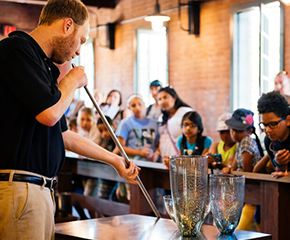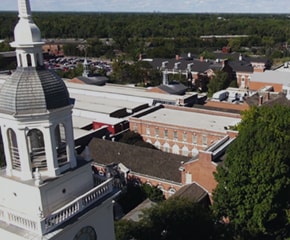Attaching Gas Tank to Chassis, Ford Motor Company Highland Park Plant, circa 1914
Add to SetSummary
On the chassis assembly lines, frames, axles, gas tanks, engines, dashboards, wheels, radiators, and bodies came together in that order to produce finished, running automobiles. Workers install gas tanks sliding down from the overhead platform to the assembly line. Tanks contain a gallon of gas so that the Model T cars could be started at the end of the line. …
On the chassis assembly lines, frames, axles, gas tanks, engines, dashboards, wheels, radiators, and bodies came together in that order to produce finished, running automobiles. Workers install gas tanks sliding down from the overhead platform to the assembly line. Tanks contain a gallon of gas so that the Model T cars could be started at the end of the line.
The Ford Model T production process was constantly changing. The design of the parts of the car, the materials from which the parts were made, the location of the factories, the layout of buildings within the factories, the layout of machines within the buildings, the design of the machines themselves, the jobs of the workmen -- all of these were constantly scrutinized and revised in the Ford Motor Company's relentless drive to lower the cost and raise the rate at which it turned out Model Ts. The assembly process moved from south to north in Building H of the Highland Park Plant. On the chassis lines, frames, axles, gas tanks, engines, dashboards, wheels, radiators, and bodies came together in that order to produce finished, running automobiles. Ford's experiments with a chassis line began in August 1913 and continued into the following year. Engineers tried different numbers of workmen and different timings of material delivery. Sometimes they pulled the chassis along by a rope and a windlass. Sometimes they pushed the chassis along on its own wheels. By early 1914 a chain-driven line was in operation. By mid-1914 three parallel lines were in operation. By this time, a Model T could be assembled in a bit more than one and a half man-hours, compared to twelve and a half man-hours needed when using station assembly.
Artifact
Photographic print
Subject Date
circa 1914
Collection Title
On Exhibit
By Request in the Benson Ford Research Center
Object ID
84.1.1660.P.833.455
Credit
From the Collections of The Henry Ford. Gift of Ford Motor Company.
Material
Paper (Fiber product)
Technique
Gelatin silver process
Color
Black-and-white (Colors)
Dimensions
Height: 8 in
Width: 10 in





